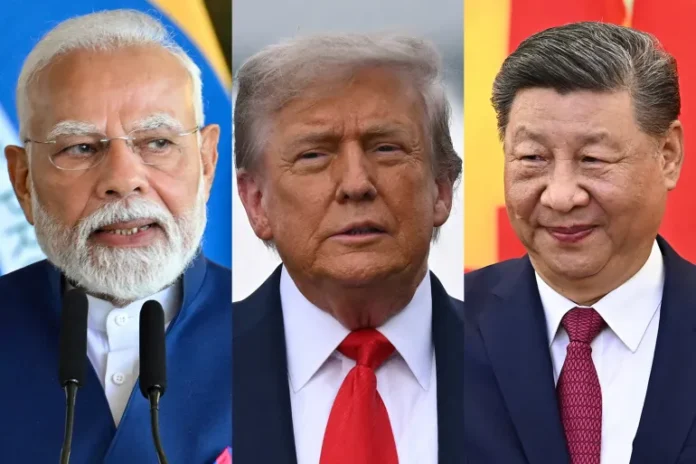New Delhi: Chinese President Xi Jinping’s secret letter to India in March 2025 marked a turning point in India-China relations at a time of intense US tariff pressures led by Donald Trump. The confidential outreach was addressed to Indian President Droupadi Murmu and subsequently relayed to Prime Minister Narendra Modi, shaping a strategic realignment that stunned global observers, including Trump, according to a report.
The outreach set the stage for a recalibration of India-China relations and triggered a fresh wave of diplomatic interactions that gained visible momentum by June 2025. This shift came at a time when India’s trade talks with Washington soured after former US President Donald Trump’s repeated—and controversial—claims of brokering a ceasefire between Pakistan and India, alongside his unprecedented decision to impose a punitive 50% tariff on Indian exports in response to New Delhi’s continued purchases of discounted Russian oil.
Xi’s letter emerged as Trump imposed harsh tariffs on both China and India, levelling up to 145% on Chinese goods and 50% on Indian exports. Fearing an India-US alignment that could further isolate China, Xi explicitly voiced concerns about any trade agreements between Delhi and Washington that might “harm China’s interests”. He named a provincial official to serve as China’s new diplomatic point for India, signalling a dedicated effort for rapprochement.
In his secret letter to India, Xi Jinping specifically expressed concern that US-India trade deals or strategic agreements could “harm China’s interests” by facilitating outcomes unfavourable to Chinese economic and geopolitical positions.
US-India trade arrangements could result in India supporting harsh US tariffs designed to isolate China’s goods and technology, thereby deepening China’s economic challenges during the tariff war.
Xi was apprehensive that India, through US-backed investments or joint ventures, might join supply chain initiatives aimed at side-lining Chinese firms and manufacturing.
Strategic cooperation, particularly military or technology-focused collaborations, between Washington and New Delhi could further shift the regional balance against China’s interests, especially in areas like defence, cyber, and critical infrastructure.
Xi also highlighted concerns that India’s alignment with US positions on border disputes, Indo-Pacific security, and potential economic sanctions could embolden anti-China coalitions and disrupt the “strategic autonomy” China prefers for its neighbour.
Initially, India maintained caution, but as American tariffs began disrupting vital export sectors and as Trump made controversial claims about mediating in regional conflicts, New Delhi became more receptive to Beijing’s overtures. By June, India had started reciprocating, opening up avenues for talks and confidence-building measures. Beijing reopened the Mount Kailash pilgrimage route, facilitated visas, and resumed direct flights, while Delhi restored Chinese tourist visas and accepted China’s support against “unfair and counterproductive” US tariffs.
Since mid-2023, quiet but steady negotiations between India and China over border troop disengagement had lowered immediate tensions along the Line of Actual Control, creating space for meaningful dialogue. Indian policymakers now argue that closer economic cooperation with Beijing could inject much-needed stability into the Indian economy at a moment of global volatility. China, meanwhile, has amplified the positive momentum by issuing public statements celebrating the bilateral relationship, a rare gesture that followed Xi’s secret letter.
Analysts believe this emergent détente threatens to alter decades of careful US engagement with India, potentially shifting New Delhi’s strategic calculus away from Washington’s orbit. For India, balancing economic security, great-power diplomacy, and military preparedness now becomes increasingly delicate as Beijing’s overtures converge with Washington’s pressure—reshaping Asia’s power landscape at a pivotal juncture.
In the lead-up to the August 31 SCO Summit in Tianjin, China, the two countries revived efforts to resolve longstanding border disputes, including the volatile Line of Actual Control, and agreed to set up new border management mechanisms. There was also progress in hydrological data sharing, trade facilitation, and border trade at key passes, reflecting a thaw unseen since the 2020 Galwan Valley clash.
Xi’s secret overture is widely viewed as a calculated move to pre-empt a US-led Indo-Pacific bloc, offering India valuable economic opportunities at a moment when US tariffs threatened its manufacturing and exports. By accepting China’s outreach, Modi sent a clear message to Washington about India’s strategic autonomy and willingness to pivot eastward if pushed too hard. The diplomatic thaw also prepared the ground for Modi’s direct meetings with Xi Jinping, Vladimir Putin, and the Iranian president at the summit, setting the stage for a redefined Asian balance.
Key follow-ups included high-level meetings between India’s National Security Adviser Ajit Doval and Chinese officials, Foreign Minister Jaishankar’s trips to Beijing, and the resumption of Indian pilgrimages and commercial exchanges. This cascade of confidence-building gestures demonstrated both sides’ commitment to overcoming past hostilities through pragmatic engagement precipitated by external pressures—most notably, Trump’s trade war.
The Xi-Murmu exchange, therefore, represents a pivotal moment in Asian diplomacy, reshaping India-China ties and altering the calculus of US-China-India relations as Prime Minister Modi prepares for crucial dialogues in Tianjin.






